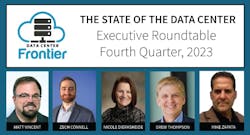Roundtable: Best Chances for Future Sustainable Data Center Onsite Power Generation
For today's installment of Data Center Frontier's Executive Roundtable, our four data center industry leaders share their opinions on the range of currently available and proposed technologies to remediate looming need for sustainable onsite power generation at large data center campuses.
Which onsite power generation solutions present the best outlook for investors, developers and providers seeking to balance short- and long-term ROI considerations with the industry’s clear and present drive toward sustainability?
Options, of course, range from speculation surrounding just barely-within-reach nuclear SMR and microreactor technologies, to lofty promises of green hydrogen solutions, to possibly more readily feasible and pragmatic means including renewable microgrids, clean fuel cells, and more efficient diesel generation and battery backup technologies and practices.
Our Executive Roundtable's expert panelists include:
- Zech Connell, VP, Program Development, BluePrint Supply Chain
- Nicole Dierksheide, Director - Category Large Engines>600KW, Kohler Co.
- Drew Thompson, Associate VP, Commercial, Connectivity and Industrial Group, Black & Veatch
- Mike Zapata, Head of Data Centers, Siemens Smart Infrastructure USA
Now onto the third question for our Executive Roundtable for the Fourth Quarter of 2023.
Data Center Frontier: The range of available and proposed technologies to remediate looming need for sustainable onsite energy generation at large data center campuses ranges from still barely-within-reach SMR and green hydrogen speculation, to possibly more readily feasible and pragmatic means including renewable microgrids, clean fuel cells, and more efficient generator and battery practices and technologies. Which onsite power generation solutions present the best outlook for investors, developers and providers seeking to balance short- and long-term ROI considerations with the industry’s clear and present drive toward sustainability?
Zech Connell, BluePrint Supply Chain: Whatever can be produced quickly is sufficient in our opinion.
Both the demand and the money are in the present. Today's problems must be addressed without compromising efforts to create a more sustainable tomorrow.
If an option becomes too distant due to manufacturing capacity constraints or other supply chain disruptions, it risks being rendered obsolete by the breakneck pace of innovation, or being deemed too unwieldy due to the rapid emergence of a more available and accessible technology.
Nicole Dierksheide, Kohler: Maintenance of a product is a key component for investors to analyze when evaluating ROI and its attachment with environmentally friendly best practices in the back up power space.
Kohler recently launched a hydrogen fuel cell product line to support more sustainable energy solutions. As access to hydrogen increases, power systems with solid polymer electrolyte (PEM) technology provide the same level of performance as conventional backup solutions with zero emissions at the point of use, alleviating the permitting challenges experienced by many data center operators today.
Additionally, Kohler also recently launched the Kohler Conscious Care Program which features fuel-saving No-Load Exercises that enable a diesel generator’s regular monthly exercise to be run without load and still avoid any "wet stacking."
This allows customers to reduce GHG emissions by 40% per year compared to loaded cycles, while also delivering a 44% reduction in fuel consumption – therefore meeting regulations and reducing fuel costs.
The program’s four-month Extended Exercise goes even further, allowing customers to perform the test every four months with no load, reducing total GHG emissions by 69% and fuel consumption by 71%.
In addition, the Conscious Care maintenance program enables an operating method that reduces noise emissions and appearance of black smoke at cold start.
In addition to needing to educate the data center community on the availability and effectiveness of more green energy solutions, we could also do a better job of sharing this information. Some of the industry’s major players have begun to incorporate more sustainable practices into their building process.
For example, Microsoft has started looking at using smaller nuclear reactors to power data centers as an alternative. If the use of nuclear technology proves viable for Microsoft and they develop an effective data center design, sharing that knowledge with the industry will advance efforts to reduce emissions.
Drew Thompson, Black & Veatch:
• Data center operators are planning to rely on a combination of on-site power solutions to meet their needs in the future including classic renewables, nuclear and hydrogen power at scale. Properly designed microgrids will allow data centers to draw upon several sources of power based upon availability and financial benefits to provide for the Gigawatt-scale sites being planned.
• 7x24x365 facilities are utilizing temporary on-site natural gas generators to overcome shortfalls in utility capacity and to provide for bridging power. They are planning to convert them to backup power generators or to future-proof them with combined cycle generation, carbon capture or hydrogen fuels capabilities for the long term.
• Several SMR [Small Modular Reactor] technologies have recently progressed their licensing applications with the Nuclear Regulatory Commission, offering new hope that dedicated Nuclear Power will become a reality in the next three or four years. Older and proven reactor technologies, such as Gen III boiling water and pressurized water reactors, will likely meet the least resistance to “on-site” licensing. The newer Gen IV reactors may take longer to be licensed, although they will likely be more efficient and better suited for SMR applications when ready. We expect it will take a decade or more before “on-site” SMR’s can generally be made available to data center campuses, due to prevailing public opinion and that only a few of the SMR technologies currently being developed will survive the regulatory and public review scrutiny. Until then, utility PPA agreements and behind-the-meter power currently available at some existing nuclear facilities remain the only viable option for nuclear power in the short term. And even then, moving the data center to those few successfully licensed SMR locations should prove to be the preferred solution to achieving “on-site” nuclear power for some time.
Mike Zapata, Siemens Smart Infrastructure USA: The choices here can be dynamic. The drivers really depend on the location, regulations, situation with the local grid capabilities, and financial impact.
Onsite generation is primarily used to address power availability and then to support decarbonization. In general, we see data center operators owning these assets as a last resort to address these drivers.
Siemens has also been approached to explore DBOOM (Design, Build, Own, Operate, Maintain) models with respect to onsite generation, and we’ve had experience doing this in other industries.
That said, onsite energy storage is a fantastic way for an operator to participate in the local grid and get paid through frequency or demand response contracts.
We see several of our clients committing to more micro-grid type solutions, but usually in concert with other local or community needs to capture this benefit and promote their ESG credentials.
Hydrogen, particularly when generated with renewable power, is a potential game changer, but it’s still quite immature as a fully mainstream solution. The primary impediments here are cost, scale, storage and lack of infrastructure.
Finally, SMR is an emerging discussion but likely not a short-term asset that a data center operator is able to own/operate and run through the regulatory paces, as well as a NIMBY [not in my backyard] challenge.
In short, grid-scale battery energy storage, coupled with intermittent renewable generation in a microgrid configuration, has the most promise today.
Next: Manufacturing Outlook and Possibilities for U.S. Data Center Supply Chains
About the Author
Matt Vincent
A B2B technology journalist and editor with more than two decades of experience, Matt Vincent is Editor in Chief of Data Center Frontier.
![In a notable announcement earlier this year, Vantage Data Centers said it would continue rollout of HVO [Hydrotreated Vegetable Oil] biofuel for use in data center diesel generators in several of its largest markets, including its Cardiff, Wales campus, pictured here, in working toward its commitment to reach net zero carbon emissions by 2030. In a notable announcement earlier this year, Vantage Data Centers said it would continue rollout of HVO [Hydrotreated Vegetable Oil] biofuel for use in data center diesel generators in several of its largest markets, including its Cardiff, Wales campus, pictured here, in working toward its commitment to reach net zero carbon emissions by 2030.](https://img.datacenterfrontier.com/files/base/ebm/datacenterfrontier/image/2023/12/65761af15622d1001ec7ad3d-vantagecardifffull.png?auto=format,compress&fit=fill&fill=blur&q=45?w=250&width=250)







